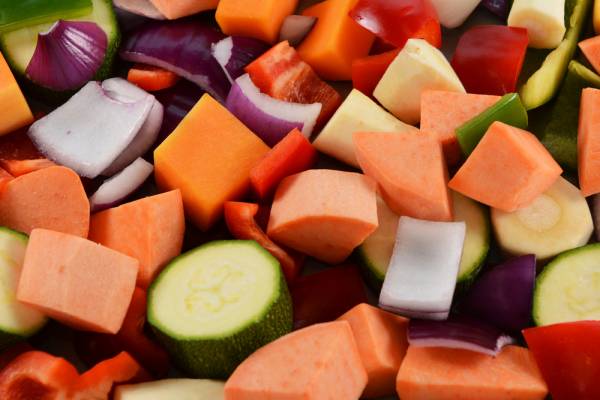Macronutrients, micronutrients, nutrient density, calorie counting. All of this nutrition terminology swims around in our heads most of the day.
Unfortunately, to maximize the value of the food we eat, we must be willing to do a little math and a little cooking. But none of us want to spend all of our time counting and cooking, so what can we do to maximize the nutrient density of every meal?
Nutrition 101
Macronutrients – carbohydrates, proteins, and fats – are the basic math of nutrition whereas micronutrients are the next level, or the algebra, of nutrition. Micronutrients, such as vitamins and minerals, are just as important as macronutrient ratios.
For example, a sweet potato is high in carbohydrates (macro), but it is also dense in beta-carotene and potassium (micro). To keep track of the micronutrient algebra of our nutrition, there are websites and calculators with endless lists of food and both their macro- and micronutrient content.
The Calculus of Nutrition
I was putting my intake into one of these tracking sites recently and I noticed a significant difference between two servings of broccoli. One day, I tracked one cup of raw, chopped broccoli and the next day, one cup of cooked broccoli. Going through my nutrient list, I noticed the site had the macronutrients the same, but the micronutrients were less for the cooked broccoli. Where does that difference come from?
The answer is the calculus of nutrition. In 1982, the USDA compiled relevant scientific literature on the study of nutrient depletion in cooked foods. An extensive study done in 1975 and led by Elizabeth Murphy showed that all foods have specific retention factors for different nutrients based on cooking method.
“A retention factor is the proportion of micronutrients still present after cooking a food from its raw form.”
A retention factor is the proportion of micronutrients still present after cooking a food from its raw form. There is also a separate retention factor for reheating a food that has already been cooked. Original retention factors were calculated based on the weight of foods before and after cooking. This data was used to compile tables that are now public through the USDA website.
The tables contain various categories of foods and multiple preparations including baked, boiled, and reheated. Under each cooking method is a list of micronutrients, which includes sixteen vitamins and eight minerals. For each of these is a number usually from fifty to 100. This number indicates the percentage of that nutrient that remains after the selected cooking process. So, if you know the amount of vitamin A in raw broccoli, and you would like to know how much will remain after boiling, simply multiply the original amount of vitamin A by the percentage in the table.

Effects of Heat
Specific micronutrients that can be destroyed or significantly decreased by high temperatures include vitamin A and beta carotene, vitamin C, thiamine, folate, and pantothenic acid. Even though steaming and boiling seem like the healthier cooking methods, thiamine, riboflavin, niacin, biotin, vitamin C, folate, and vitamins B6 and B12 are unstable when in contact with water.
So, the amount of micronutrients remaining depends on a multitude of factors other than cooking process. Many micronutrients are fickle in stability and can begin to degrade even by exposure to air. Other possible modes of destabilization include exposure to water, exposure to light, and the presence of an acidic or basic medium.
Make the Most of Micros
That said, certain cooking processes can help make micronutrients more available to our bodies. For example, the starch in root vegetables such as potatoes is more easily digested after cooking. Also, the lycopene in tomatoes is intensified and made more available by heat.
“Many micronutrients are fickle in stability and can begin to degrade even by exposure to air. Other possible modes of destabilization include exposure to water, exposure to light, and the presence of an acidic or basic medium.”
For the sake of simplicity, the USDA charts categorize this increase in micronutrient availability as 100% even if in actuality, it is greater than 100. The USDA updates the tables whenever there is enough information to add a new food group or a new micronutrient. The most recent update to the tables occurred in 2007 with the addition of total choline, which is classified as a water-soluble B vitamin.

Food Sources Are Best
Many of us rely on a daily multivitamin to fill in the gaps, but the only vitamin supplement shown to have any proven benefits in healthy individuals is vitamin D, which is a fat-soluble vitamin and should be consumed with food. Of course, consult your physician if you have questions, but most of us will get the best nutrition directly from healthful, nutrient-rich food.
To be sure that you are getting sufficient micronutrient value from food alone:
- Compute your needs using this USDA calculator.
- Check the nutrient value of food, especially fruits and veggies, in raw form.
- Do a little prep work and planning to keep macronutrients at desired ratios.
- Use the latest USDA nutrition retention factor charts to be sure that whatever cooking method you choose does not destroy your macronutrients.
- Supplement appropriately, if you choose.
The USDA charts linked above are handy to get the most nutrition from your food. It can be easy to become dependent on supplements when we are short on time. But many of us would like to get into the calculus of our nutrition and maximize the healthfulness of every meal.
You’ll Also Enjoy:
- Why “If It Fits Your Macros” Isn’t a Fit For Me
- Your Micronutrients Can Help Your Performance
- The Importance of Micronutrients in a Cyclist’s Diet
- New on Breaking Muscle Today
References:
1. Kreutler PA and Czajka-Narins DM, Nutrition in Perspective, 2nd edition. Englewood Cliffs, New Jersey: Prentice Hall, 1987.
2. Erdman, et al., “Absorption and transport of carotenoids.” Ann NY Acad Sci, vol. 691, pp. 76-85, 1993.
3. Clifford AJ, et al. “Bioavailability of folates in selected foods incorporated into amino acid-based diets fed to rats.” J Nutr, vol. 120, no. 12, pp. 1640-1647, 1990.
4. Johnson L. “Thermal degradation of carotenes and influence on their physiological functions.” Adv Exp Med Biol, vol. 289, pp. 75-82, 1991.
5. Dietary supplements: Using vitamin and mineral supplements wisely, Mayo Clinic.
6. National Health Service. “Vitamins and nutrition in pregnancy“. NHS Choices. NHS. Retrieved 10 January 2014.
Photos courtesy of Shutterstock.






